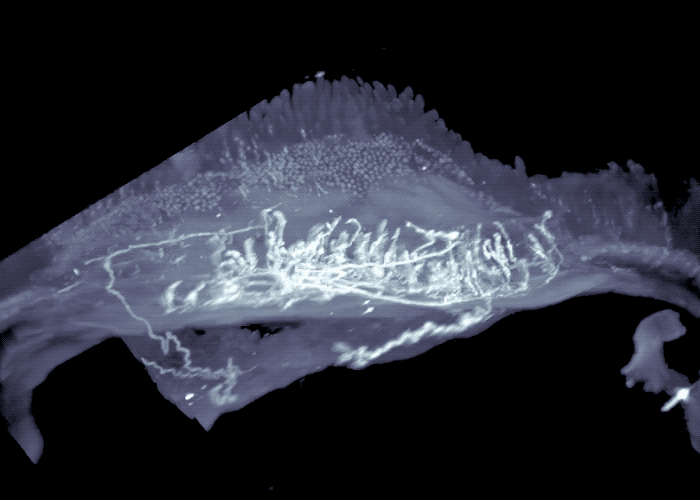Tapping into our Senses
by Lindsay Borthwick
Our senses continue to yield their secrets

The Author
The Researchers
Our senses continue to yield their secrets. Neuroscientists have recently learned how a single receptor on neurons responds to so many noxious substances. A separate study shows that the gut—the body’s 100-million-neuron-rich “second brain”—is also exquisitely tuned to its contents, sensing fatty acids produced by intestinal microbes that can directly influence gut motility. But our senses can be deceived, as a third study in this month’s roundup of research highlights reminds us. Salk researchers are drawing on decades of research into visual perception—and how the memory of visual information can be distorted—to improve eyewitness identification.
Eye-watering results
Our senses guard us against innumerable dangers including noxious chemicals in the environment, from irritants found in everything from smoke to tear gas to onions, garlic and wasabi. The irritants—a class of chemicals known as “reactive electrophiles”—activate TRPA1, informally known as the “wasabi receptor,” in neurons of the mucous membrane, triggering eye-watering, coughing and other protective responses. Back in 2015, David Julius, PhD, and Yifan Cheng, PhD, both researchers at the University of California, San Francisco, described TRPA1’s protein structure. (Julius is co-recipient of the 2020 Kavli Prize in Neuroscience for his work on these molecular sensors. Yifan Cheng is a member of the Kavi Institute for Fundamental Neuroscience at UCSF.) Working together, the two labs have now figured out how TRPA1 senses so many different chemicals—and discovered that its mechanism is unique. The discovery was enabled by advances in microscopy that allowed the team to take a series of “structural portraits” of TRPA1 as it interacted with different molecules. “I think this represents the future of structural biology,” said Cheng in a UCSF news article. “The days of just getting one structure and publishing a paper are over. Now we have the technology to tell complex, interesting stories about the molecular machines that make our cells function.”
More than a gut feeling
The gut microbiome and its impact on the nervous system is the focus of intense interest and study. Now, researchers at The Rockefeller University have discovered a gut-brain circuit that regulates gut motility and is influenced by the composition of the microbiome. It’s an elegant demonstration that gut microbes play a direct role in neuronal communication and the physiology those neurons control. “We describe how microbes can regulate a neuronal circuit that starts in the gut, goes to the brain, and comes back to the gut,” said senior author Daniel Mucida, PhD, associate professor and head of the Laboratory of Mucosal Immunology, in a news article. “Some of the neurons within this circuit are associated with irritable bowel syndrome, so it is possible that dysregulation of this circuit predisposes to IBS.” Mucida is a faculty member of the Kavli Neural Systems Institute at Rockefeller.

Predicting painful flare ups
An article in Science magazine details the discovery of a new cell type that builds up in the blood a week before a person experiences a flare up of rheumatoid arthritis, a debilitating autoimmune disease characterized by pain and inflammation in the joints. At the molecular level, the cells—newly named pre-inflammatory mesenchymal (PRIME) cells—resemble bone, cartilage or muscle cells. Though it is unclear whether the cells cause arthritic attacks, their discovery could help patients and physicians predict and manage flare ups, or possibly even prevent them. The research, led by neuro-oncologist Robert Darnell, MD, PhD, at The Rockefeller University, was made possible by a new method for preserving RNA in blood, which allowed patients to mail in blood samples on a regular basis for the duration of the four-year study. Darnell, who is a faculty member of the Kavli Neural Systems Institute, and his team are already adapting the sampling technique to study the immune reaction in COVID-19 patients recovering at home, according to the article. The researchers also plan to replicate the findings in additional patients.
Neuroscience at the precinct
New research that reimagines the way eyewitness identification in police lineups is performed could reduce wrongful convictions in the criminal justice system. The new approach, described in a study published this month in Nature Communications, applies decades of research into how the brain processes and remembers visual information—including how the context for what we see affects our perceptions of it. In so doing, the approach overcomes the decision bias inherent to the most common lineups methods used in law enforcement. “Traditional lineups just reveal the top choice—the tip of the iceberg. But the cause of the witness’s decision is ambiguous. It may reflect strong memory for the culprit, or it may mean that the witness was not very discerning. Our new procedure overcomes that ambiguity by revealing the strength of recognition memory for all lineup faces,” said Salk Institute professor Thomas Albright, PhD, an expert of visual perception and recognition who is also a member of the Kavli Institute for Brain and Mind.
Simple solutions to hard problems
A profile of Carey Priebe, PhD, a mathematician at Johns Hopkins University, traces his journey from a farm in Iowa to the Department of Applied Mathematics and Statistics at Johns Hopkins University, where he uses graph theory and other statistical techniques to find patterns in chaotic data. He has worked on an astonishing array of problems: Locating martian volcanoes? Check. Uncovering money laundering? Identifying human traffickers? Check. Check. Matching neurons in the larval fruit fly brain? Check that, too. In fact, Priebe is affiliated with the Kavli Neuroscience Discovery Institute (Kavli NDI) at Hopkins, where he frequently collaborates with a former student, Joshua Vogelstein. Kavli NDI, which launched in 2015, is designed to bring together experts in neuroscience, engineering, and data science, with the ultimate goal of reaching a unified understanding of brain function. Vogelstein says of his mentor: "Carey is really good at making things simpler. It's relatively easy to have a complex idea that might work. It's much harder to have a simple idea that will work."